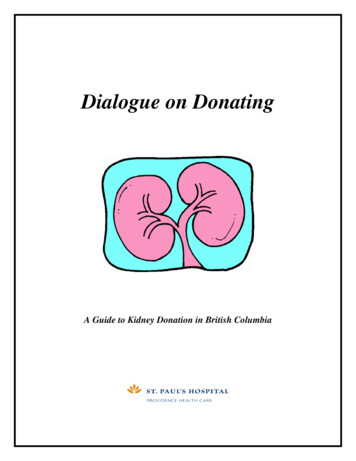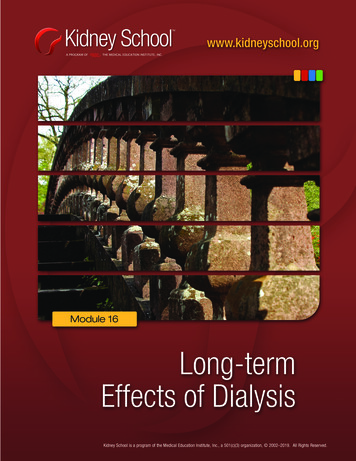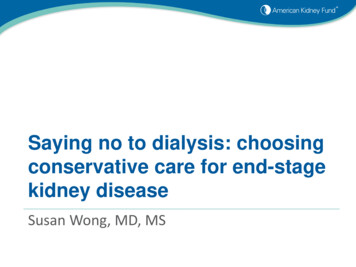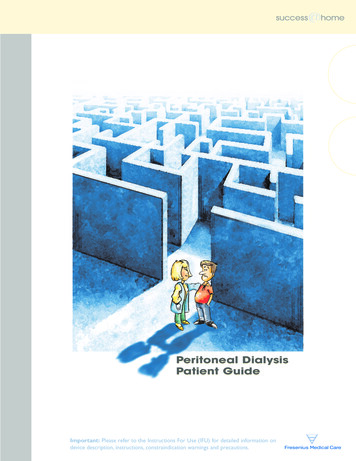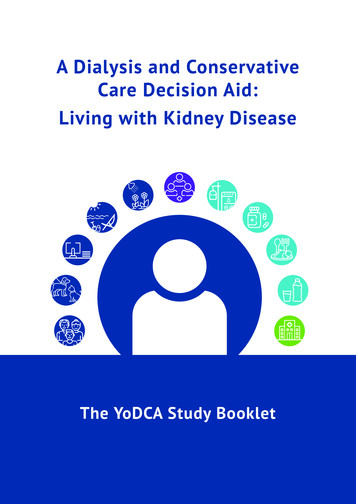
Transcription
A Dialysis and ConservativeCare Decision Aid:Living with Kidney DiseaseThe YoDCA Study Booklet1
About the BookletThis booklet is for people with chronic kidney disease that is getting worse, and who aremaking decisions between conservative care or dialysis pathways. It aims to help peopleand their families talk with health professionals about these different pathways and whyone option suits a person’s life better than the other.The booklet has been developed by the Yorkshire Dialysis and Conservative CareDecision Aid (YoDCA) study team. There are more details about the study at the end ofthe booklet (see pages 26-27).This research was funded by:More copies of this booklet are available from Kidney Research Yorkshire’s ca or ask your kidney team.Please write your name in the space below. Then the booklet can be returned to youif you leave it in clinic.Name: . . . . . . . . . . . . . . . . . . . . . . . . . . . . . . . . . . . . . . . . . . . . . . . . . . . . . . . . . . . . . . . . . . . . . . . . . . . . . . . . . . . . . . . . . . . . . . . . . . . . . . . . . . . . . . . . . . . . . . . . . .Kidney unit: . . . . . . . . . . . . . . . . . . . . . . . . . . . . . . . . . . . . . . . . . . . . . . . . . . . . . . . . . . . . . . . . . . . . . . . . . . . . . . . . . . . . . . . . . . . . . . . . . . . . . . . . . . . . . . . .Disclaimer:Every effort has been made to provide accurate information at the date of publication (July 2020).However, facts about managing kidney disease with dialysis and conservative care, and how you want tolive your life, can change over time. Check with your kidney team about the facts you are using to makeyour decisions.Date of next content review and update: January 2022.
ContentsPeople use this booklet in different ways. Most people read it a few times, on their ownand with family and friends. People use the prompts in this booklet to talk with healthprofessionals and plan which option fits into their everyday life best [1,2].To help people focus on what is important to them about their experience of illnessand treatment decisions, the booklet is split into sections:Section A: Chronic and Established Kidney DiseaseSection B: Conservative Care and DialysisSection C: My Decisions about Conservative Care and DialysisSection D: Next Steps for CareFurther Information: Glossary, Patient Information, References, Study Details.Each section has information and a decision map, and prompt to help people thinkthrough this decision:Information and tables provide facts about treatment for kidney disease. Somesentences have numbers in brackets like this: [1,2]. These numbers link the informationin the sentence to references. The references or sources for these facts are listed onpage 24-25.Decision maps show the focus of each section and how it links with other informationin the Booklet.Prompts help people note down any questions and thoughts that are important tothem when making this decision.3
Section A: Chronic andEstablished Kidney DiseaseThis section has information about chronic and established kidney disease, and howkidney professionals can help people manage their kidney disease.Chronic kidney disease (CKD) is a long-term health problem where people’s kidneysslowly stop working (see Picture 1). Damaged kidneys cannot do their usual jobs tokeep our bodies healthy. The types of jobs that kidneys do are: Filter and clean the blood so waste products (toxins) and excess water canleave our bodies as urine Control the balance of water and minerals (e.g. potassium, sodium) to keepour bodies well Make hormones that control other functions (e.g. blood pressure, anaemia) Balance acidity levels (pH) in the blood Control the calcium levels the body needs for healthy bones.Health professionals who are expert in managing kidney problems care for peoplewith CKD. They might be called a specialist kidney, renal or nephrology doctor, nurse,dietician, psychologist or therapist. CKD is a life-long illness, and kidney units workwith other health professionals to manage people’s health as they get older (old-age orgeriatric professionals), if they have other health problems, their kidney function getsworse (palliative care professionals), or kidney treatments stop working (communitybased health and social care professionals).Established kidney disease (EKD) is the name used to describe CKD that is getting worse,when the kidneys gradually stop working. It is discussed in more detail later in this section.Picture 1: Where the kidneys are in the body and how the kidney worksLungs‘Dirty’ blood withwastes and waterHeartStomachLiverKidneys4‘Cleaned’blood withoutwastes andexcess waterUrine tobladder
Making Treatment Decisions with Kidney ProfessionalsKidney professionals and people with CKD make decisions together about thetreatments that will fit best into their everyday life to a) protect their kidneys,b) slow down damage to their body from losing kidney function, and c) manage anysymptoms from their CKD getting worse.These decisions help people plan their EKD management with their kidneyprofessionals along a care pathway.The decision maps in this booklet can help people see the different care pathways forpeople with CKD over time [1,2] (see Decision Map 1).Decision Map 1: Planning Care Pathway and Treatment Decisions for People with EKDChronic kidney disease1. Which care pathwaybest suits my life now,and for the future?2. Which treatment optionmanages my symptomsand fits into my life?Established kidney disease(EKD planning about 15 eGFR)Kidney care and symptom managementConservativeCareMedicine,diet and lant /-LivedonorKidney and treatment failure3. Which care pathwayhelps me live as I wantto, at the end of life?DeceaseddonorSwitchingStoppingEnd of life care (EoLC planning)Palliative and location of care managementKidney professionals use details from people’s kidney test results, experience ofsymptoms, other health problems or illnesses, and any lifestyle changes to giveinformation about different options and care plans.Some decisions happen often as part of CKD care, such as adjusting diet, medicines,fluid and exercise, to keep kidneys as healthy as possible (see Table 1). Other decisionshappen less often, such as a change of care pathway when tests show CKD is gettingworse, or treatments are not working as well as they did (see Section B).5
Table 1: Tips For Keeping Kidneys as Healthy as Possible [3]To slow down the loss of kidney function: Go to your regular kidney unit appointments - monitoring your well-being andregular tests can pick up changes to your health before you get symptoms Check your blood pressure at home or get it checked regularly, and take bloodpressure medications - high blood pressure damages kidneys Ask pharmacists about any ‘over the counter’ medicines and ‘natural’ remediesyou are planning to take, to check if they can damage the kidneys in peoplewith EKD Follow the instructions for taking all medications your doctors give you Have a winter flu jab every autumn - people with EKD are more likely to getinfections Get advice from a pharmacist, GP or kidney team about treating infections,high temperatures and diarrhoea quickly - getting dehydrated can damagethe kidneys If you have diabetes, avoid high blood sugar levels - diabetes damages theblood vessels in kidneys Give up smoking or at least cut down - smoking speeds up kidney damage Give up alcohol or at least cut down - alcohol speeds up kidney damage Do some exercise 2-3 times a week - regular exercise helps keep kidneyshealthy Keep a healthy weight - being overweight means your body, and kidneys,have to work harder Cut down on salt - salt can lead to high blood pressure which damages thekidneys.6
Established Kidney DiseaseIf a person’s CKD worsens, it means their kidney function keeps getting lower, and thischange is known as kidney failure. Kidney function is worked out from regular tests onestimated glomerular filtration rate (eGFR) and albumin to creatinine ratio (ACR). Whena person’s eGFR gets to about 15, the CKD has worsened to a stage sometimes calledadvanced or established kidney disease (EKD) [1,2]. Some people think about kidneyfunction as a percentage, going from 100% (fully functioning) to 0% (no function; seePicture 2) [1,2].When people are told they have EKD, it can affect their lives, how they feel, and the livesof those around them. People can feel shock, grief and denial at first. Some people find itdifficult to concentrate and think clearly. It is common for people to experience anxiety,depression, concerns about body image, loss of self-confidence, and a loss of interestin sex. These feelings and problems may go away by themselves as people get usedto living with EKD. Some people find sharing their experiences with their kidney team,patient support groups and their family can be useful (see page 23 for support groups).Picture 2: Loss of Kidney Function and Changes to Kidney Disease Stage [2]100%90%Full kidney function(100%)Normal function(90-99%)No kidney disease80%70%Some loss of function(60-89%)60%50%40%Mild loss of function(45-59%)Chronic kidney diseaseModerate loss of function(30-44%)30%20%10%0%Severe loss of function(15-29%)Kidney failure(1-14%)Established kidneydiseaseNo kidney function(0%)End of life(if no kidney replacement)7
Kidney Care and Symptom ManagementPeople with EKD have regular meetings with kidney professionals to monitor howthe loss of kidney function is affecting their body and health, and any side effects oftreatments. Some people with EKD may not feel ill or know their symptoms can be linkedto EKD (see Table 2). The regular check-ups include blood, urine and blood pressure tests,monitoring of symptoms, and changes to everyday life.Many professionals help people manage their loss of kidney function and thesymptoms caused by EKD. These include specialist teams of kidney (sometimesknown as renal or nephrology) doctors and nurses, dieticians, occupational therapists,clinical psychologists, counsellors, social workers, GP, community nurses, pharmacistsand physiotherapists. Different kidney units organise their EKD care and services indifferent ways. All kidney units follow national guidance about the care they offer[e.g. NICE NG107 4].Table 2: Managing Symptoms of Kidney Disease [5,6]8SymptomsTreatments and TherapiesTiredness, low energy, fatigue,feeling coldTablets, injections for iron balanceItchingTablets, creams, psychological supportNausea, vomiting, loss of weightor appetiteTablets, support with managing protein andnutrients in dietSwollen legsTablets, control of fluid, diet and saltMemory or concentration loss,sleep problemsTablets, monitoring, psychological supportMuscle and joint painTablets, psychological supportLeg cramps, restless legsTablets, support with diet, psychological supportBack painMonitoring, support with fitness, psychologicalsupportDizziness, visual problems,headachesTablets, monitoring, psychological support,expert support for eyesShortness of breathTabletsLoss of muscle strengthMonitoring, support with fitnessMuscle spasms, stiffnessTablets, support with fitness and dietLoss of sex driveMonitoring, psychological supportNeed to urinate more oftenTablets, support with diet and fluid
Section B: Conservative Careand DialysisWhen people are told their CKD is getting worse, they can find it difficult to understandwhat this means for their health and managing their EKD in the long term. Makingdecisions about care can be difficult because of a) the speed at which EKD gets worse,b) the chance that treatment can slow down the loss of kidney function, c) the waytreatment side effects vary from person to person, d) managing other health conditionslike diabetes or problems with the heart and arteries, and e) the fact that not allpeople with kidney disease have symptoms.Kidney professionals help people cope with their illness, and talk with them aboutwhich care pathway suits them best, based on their kidney test results, general wellbeing, daily activities and future plans.This section has information for people deciding between the conservative care anddialysis pathways to manage their EKD (see Decision Map 2).Decision Map 2: Deciding Between Conservative Care and Dialysis PathwaysChronic kidney disease1. Which care pathwaybest suits my life now,and for the future?2. Which treatment optionmanages my symptomsand fits into my life?Established kidney disease(EKD planning about 15 eGFR)Kidney care and symptom managementConservativeCareMedicine,diet and lant /-LivedonorKidney and treatment failure3. Which care pathwayhelps me live as I wantto, at the end of life?DeceaseddonorSwitchingStoppingEnd of life care (EoLC planning)Palliative and location of care managementKidney professionals carry out tests to see if people are suitable for a kidneytransplant. A transplant can extend a person’s life more than dialysis and conservativecare (see Box 1). Talk with your kidney team about whether a kidney transplant is anoption for you. This booklet is for people who have chosen to actively manage theirkidney disease and are not suitable for a transplant.9
Box 1: Kidney Transplant OptionKidney transplant is when a kidney is taken from a person without kidney disease(the donor) and put into the body of a person with kidney disease (the recipient).Kidney transplant operations are done by surgeons. The transplanted kidneyis placed near to the kidneys in the recipient’s body. Not everyone with kidneydisease can have a kidney transplant. As people get older, or have other healthproblems, they are less likely to be able to have a transplant operation.After a kidney transplant, people take medication for the rest of their lives tostop their body (immune system) rejecting the transplanted kidney. Transplantedkidneys do the jobs needed to keep the body healthy. They do enough work sopeople do not have to restrict their diet and fluid in the same ways as they didbefore the operation. Most people who have transplants have a better quality oflife and survival rate than those on dialysis.Some people with kidney disease put their names on a transplant waiting list.These people are given a kidney from a person who has died: a deceased donor- after brain death (DBD) or after cardiac death (DCD). People wait for a kidneyto be donated that matches their blood and tissue type. On average, people onthe kidney transplant list wait for 2-3 years [7]. Many people with kidney diseasedecide which type of dialysis to have while on the transplant waiting list. About70% of people are on dialysis at the time when they have a transplant [7].Some people are given a kidney from a person who is alive: a living kidney donor(LKD). Some people know the person, often a family member or friend, who donatesthe kidney: a directed donor. Some people do not know the person donating thekidney: a non-directed or altruistic donor. LKD begins as soon as the donor’s andrecipient’s kidneys are matched, and both people are ready to have the operations.Most transplanted kidneys start to work a few days after the operation. After oneyear, about 94% of people (94 out of 100) with a DCD kidney have a functioningkidney, and about 98% of people (98 out of 100) with an LKD have a functioningkidney [7]. Over time, the transplanted kidney can begin to lose its function. Onaverage, transplants from deceased donors last around 10-12 years, and thosefrom living donors last around 12-15 years [8, 9,10]. People whose transplantedkidney starts to fail then make decisions about kidney transplant, dialysis andconservative care.10
Planning How to Manage EKDKidney teams set aside times to meet with people, and their families when decidingto have or not have conservative care or dialysis. They want to help people decideabout how best to manage their EKD and symptoms. It is important people choose atreatment to fit with their values and the way they want to live their life (see Picture 3).These treatments do not cure EKD.Both pathways: aim to keep people well for as long as possible, in a way that fits people’svalues and daily needs include regular check-ups with kidney professionals, tests of kidney function,monitoring of symptoms, and updates on the effect of treatments and theirside effects on people’s daily life need adjusting over time as people get older, have other illnesses, makedifferent life choices, and some treatments stop working help people to manage symptoms from their EKD (see Table 2).The two pathways manage EKD in different ways, and have different effects on people’sexperience of illness, treatment choices, daily life and length of life (see Table 3).Picture 3: Thinking about what is important to you in your lifeManaging yourkidney diseaseDaily lifeKidneyprofessional teamOtherillnesses11
Table 3: Summary of management of EKD with conservative care and dialysis pathwaysConservative Care PathwayTreatments12Dialysis PathwayUses medicines, diet andfluid management, and othertreatments to keep the kidneysas healthy as possible (see Table1) and manage EKD symptoms(see Table 2).Uses equipment to clean people’sblood. Dialysis does about 10% of thework of a healthy kidney (see Table1). Dialysis and other treatments helpmanage EKD symptoms (see Table 2).Kidney care People who choose conservativecare go to their kidney unitroutinesfor regular check-ups. Peoplemay spend some time each daymanaging their EKD symptoms(see Table 2).People who choose dialysis go totheir kidney unit for regular checkups. People spend a few hours eachday managing their EKD symptoms,and extra time having dialysison some days or every day. Somepeople travel to their kidney unit tohave dialysis.DailyroutinesPeople add extra treatmentswhen they are needed to managethe symptoms of kidney failureand loss of kidney function.People add a dialysis treatmentroutine into their usual EKD careand daily life. People add extratreatments when they are neededto manage the symptoms of kidneyfailure and loss of kidney function.LifeexpectancyConservative care does notlengthen life. People’s length oflife depends on how fast theirkidneys stop working, their age,ability to do daily tasks, andother illnesses [11].Dialysis lengthens life in peoplewho are generally fit and well. Itmight not lengthen life for peoplewho are older, have other illnessesand have difficulty looking afterthemselves [11,14].Impact ondaily lifeThe way people feel about theireveryday life seems to stay thesame or may get slightly betteron this pathway [12,13].The way people feel about theireveryday life seems to stay the sameor may get slightly worse on thispathway [12,15].People have an operation tomake an access point so dialysisequipment can be used: a fistulain an arm or leg for haemodialysis(HD), or a catheter in the belly forperitoneal dialysis (PD).
Adjusting and Switching TreatmentsAfter people decide which treatment pathway to have, kidney professionals work withthem to find the best way to fit treatments and kidney care into their lives. Kidneyteams support people whether they are having their care at home (e.g. with assistedcare) or at a kidney unit (e.g. with transport). Over time, people with EKD make manydecisions with their kidney team about adjusting routines and switching treatments.People who decide to have dialysis choose which type fits best with their lifestyle. Seethe Dialysis Decision Aid for facts about haemodialysis (HD) and peritoneal dialysis(PD) options [2]. Some people think about what will happen if they switch pathwaysfrom conservative care to dialysis, or dialysis to conservative care, or stop treatments.As people’s EKD gets worse, they may have other health problems, their lifestyle maychange, treatment side effects may impact on their daily activities, or the treatmentthey have may no longer work well enough to cope with the body’s loss of kidneyfunction. People having dialysis may talk with kidney professionals about switchingto another type of dialysis or stopping dialysis treatment. Kidney professionals andpeople with kidney failure make plans about end of life care, often with help fromother health professionals and services.Table 4: Your reasons for choosing either of the care pathwaysUse this table to jot down your views about the pathways. Rate how important eachreason is to you (*somewhat important, **important, ***very important)Reasons for choosing Conservative Care PathwayImportance (*/**/*** )Reasons against choosing Conservative Care PathwayImportance (*/**/*** )Reasons for choosing Dialysis PathwayImportance (*/**/*** )Reasons against choosing Dialysis PathwayImportance (*/**/*** )13
Section C: My Decisions aboutConservative Care and DialysisThe information in this section will help you think about which pathway suits you best,and how you want to work with kidney professionals to plan your EKD managementnow, and for the future.Decision Map 2: Deciding Between Conservative Care and Dialysis PathwaysChronic kidney disease1. Which care pathwaybest suits my life now,and for the future?2. Which treatment optionmanages my symptomsand fits into my life?Established kidney disease(EKD planning about 15 eGFR)Kidney care and symptom managementConservativeCareMedicine,diet and lant /-LivedonorDeceaseddonorKidney and treatment failureSwitchingStopping3. Which care pathwayhelps me live as I wantto, at the end of life?End of life care (EoLC planning)Palliative and location of care managementMaking Conservative Care and Dialysis Pathway DecisionsKidney teams help people plan and decide on their treatment before it needs to start.Planning means people are more likely to choose the treatment that best suits theirlifestyle. It gives people time to talk about what is important to them about theirlifestyle, health and different treatments. It gives kidney teams time to plan for anychanges in the care of people’s kidney disease. When people choose dialysis, planninggives the surgeons a chance to carry out an operation to prepare people’s dialysisaccess points.People’s health is better if a treatment is planned and started before their kidneyfunction gets worse. This can be a difficult decision for some people to make. It meansweighing up what is important in their life with their experiences of kidney disease,symptoms and treatments. They have to think about how their EKD, health, well-beingand lifestyle may change over time. Table 5 summarises the facts people comparewhen making a decision about the conservative care or dialysis pathway.14
Table 5: Summary of Conservative Care and Dialysis Care PathwaysConservative CareEKD pathwayRegular check-ups andmonitoring; medicines; dietand fluid guidance; lifestylesupport (EKD care).DialysisRegular check-ups andmonitoring; medicines; diet andfluid guidance; lifestyle support(EKD care).Access point operation;equipment to clean blood; dailydialysis routines.EKD impactDaily life impactOther decisionsManage symptoms, keepkidneys healthy.Manage symptoms, keep kidneyshealthy.Length of life follows naturalLengthens life in those who arecourse of person’s kidney failure.generally fit and well.Fit EKD care routines into dailylife.Fit EKD care routines into dailylife and have dialysis regularly.Feel the same or possiblyslightly better about life.Manage dialysis side effects;feel same or possibly worseabout life.Add treatments as kidneys failand symptoms get worse.Peritoneal dialysis (PD) orhaemodialysis (HD) decision.Make advance care plans tomanage care at end of life.Add treatments as kidneys failand symptoms get worse.Make advance care plans tomanage care at end of life.Adjust or switchAdjust or switch treatments assymptoms get worse.Adjust or switch treatments assymptoms get worse. Over time,may switch or stop HD and PDoptions.Value trade-offs(see next pagefor more details)On balance, is it worth fittingEKD routines into my life now,and in the future?On balance, is it worth fittingEKD and dialysis routines intomy life now, and in the future?15
Medical studies measure a) the life expectancy of people with EKD, compared withgroups of healthy people, b) the impact of kidney treatments on how quickly kidneysstop working, symptom control and side effects, and c) different ways people cope withEKD [16,17,18,19].Different studies collect different facts in different ways. People who take part in thesestudies are usually chosen because of characteristics like age, sex, ethnicity, otherhealth problems and/or treatment. These studies mean figures cannot be calculatedfor how well different pathways work for people with different characteristics. Ask yourkidney professional if there are figures from studies of treatments that might be usefulin your EKD treatment decisions. Use Box 2 on the next page to write down any notesor questions.My Trade-offs Between Conservative Care and Dialysis PathwaysManaging EKD and its symptoms means people fit daily treatments, visits to kidneyunits, and changes to diet and fluid routines into their lives. People decide on apathway by balancing judgements about their kidney function and well-being withtheir feelings about what is most important in their lives now and for the future [20]. Anexample of a trade-off might be thinking about what is more important to you in yourdaily life now, as your kidney disease gets worse: The conservative care pathway means a chance to do daily activities (e.g. hobbies,family and pets, leisure and holidays) with fewer regular medical routines, untilthere is no kidney function left The dialysis pathway means fitting an extra set of medical procedures and routinesaround daily activities (e.g. hobbies, families and pets, leisure and holidays), with achance of lengthening life when there is no kidney function left.Given what you know about your EKD, and your reasons for and against each pathway(page 13), circle the answer for each option that best matches how you want tomanage your EKD:Table 6: Thinking about which pathway will suit me best16Conservative care pathwayYesNoUnsureDialysis pathwayYesNoUnsure
Box 2: Prompts to help you talk with kidney professionalsThis page is to help you talk with kidney professionals about your kidney health,experiences of treatment, other health concerns and daily life. Talking to family andfriends about the following topics can help you to work out if one option suits youbetter than another. Use the space below to write notes or questions to help you talkto your kidney professional.My kidney function and kidney health:My treatments and side effects:My well-being and self-care:My health and other illnesses:My hobbies and lifestyle:Other:17
Section D:Next Steps for CareThis section gives information about planning for changes in care and treatment afteryou have decided between conservative care and dialysis, and as your EKD gets worseover time.Decision Map 3: Changes in care and treatment as EKD gets worseKidney diseasecareJoint planning:Pathway ished kidney disease(EKD planning about 15 eGFR)Kidney care and symptom managementConservativeCareMedicine,diet and fluidJointplanning:Not start/stoptreatmentsLocation of carePrepare for EoLPalliative careChronic kidney disease 30% sisTransplant /-LivedonorKidney and treatment failureDeceaseddonorSwitchingStopping0% kidneyfunctionEnd of life care (EoLC planning)Palliative and location of care managementPlanning for Changes in Health with EKDOver time, people with EKD can feel more unwell and less able to do their dailyactivities. People may need more treatments to manage more symptoms or mayno longer be able to enjoy their hobbies and social activities. When these changeshappen, people can have extra care to give them comfort and symptom relief. This typeof care is called palliative care. It helps people keep a good quality of life and makecare plans with health professionals and family at the right time before their kidneysfail. Palliative care options include: Controlling symptoms and pain relief Help carrying out daily tasks such as washing, eating and dressing Emotional, spiritual and psychological support Support for family and friends.18
People on both the conservative care and dialysis pathways are asked to makeadvance care plans when they still feel well. These plans help kidney professionalsand families know what treatments to change, start or stop. They can help give peoplethe best possible quality of life for as long as possible. The plans are personal, writtendocuments that are used to plan care with others. This way, everyone knows theperson’s wishes, even if they become unable to talk about their care.Advance care plans can be made at any time, and people can change their minds abouttheir decisions if their views change. Planning when you are well helps kidney teams,primary care (your GP), and community and palliative care services to organise the bestcare for you. Your GP, community nurse or kidney professionals will help you make anadvance care plan that includes all the issues that may be important to you, such as: faith or spiritual beliefs that may influence care and death naming a person to make financial, personal and care decisions for you (lastingpower of attorney), such as a will, funeral and arrangements for pets and family stating where you would prefer to die, i.e. home, hospital or hospice decisions about treatment you do or do not want at the end of life decisions about organs, tissue and/or body for donation.Box 3: End of life care for people with worsening EKDLife expectancy for people with EKD is less than for healthy people. The mostcommon cause of death for people with EKD is from another illness they mayhave such as
which care pathway suits them best, based on their kidney test results, general well-being, daily activities and future plans. This section has information for people deciding between the conservative care and dialysis pathways to manage their EKD (see Decision Map 2). Decision Map 2: Deciding Between Co
